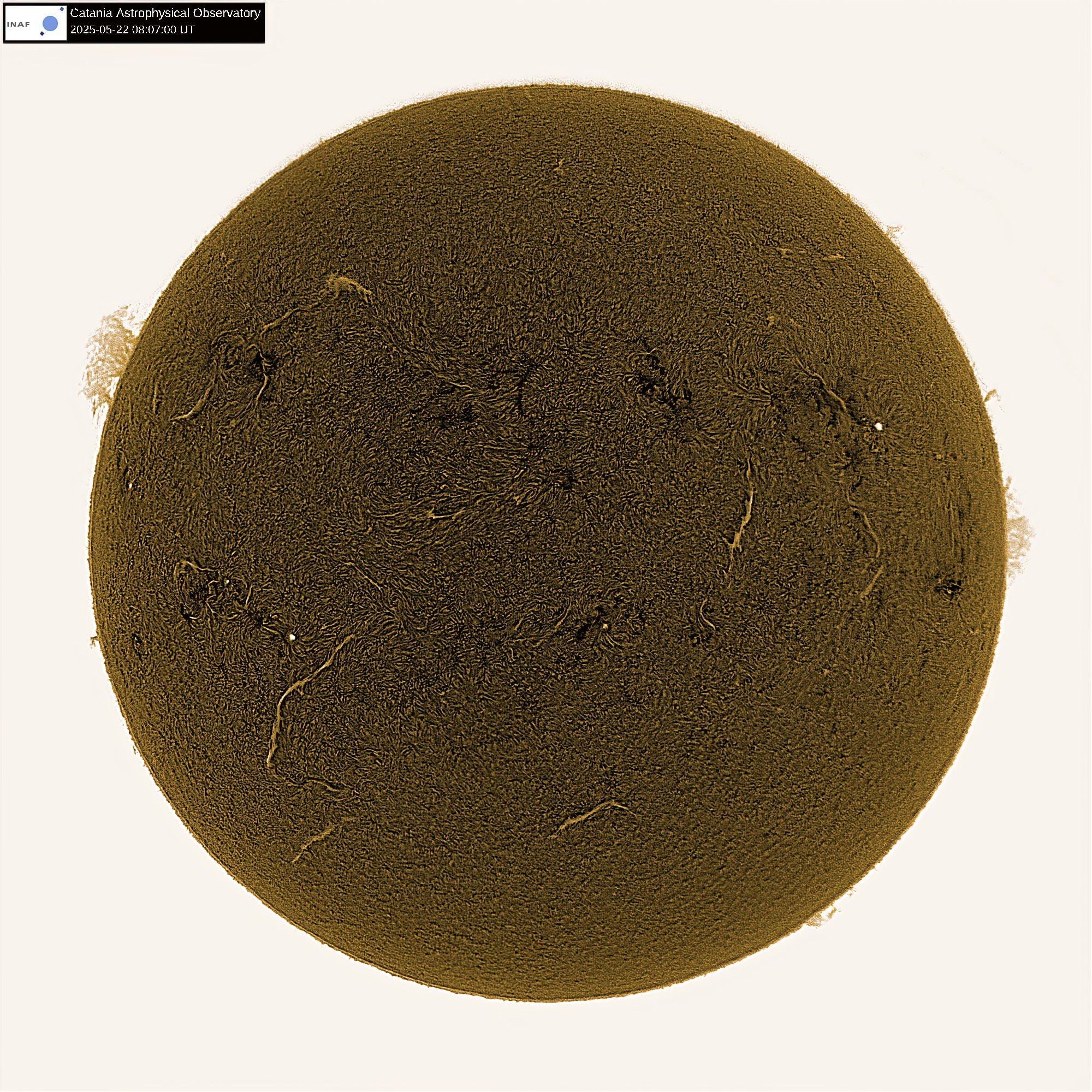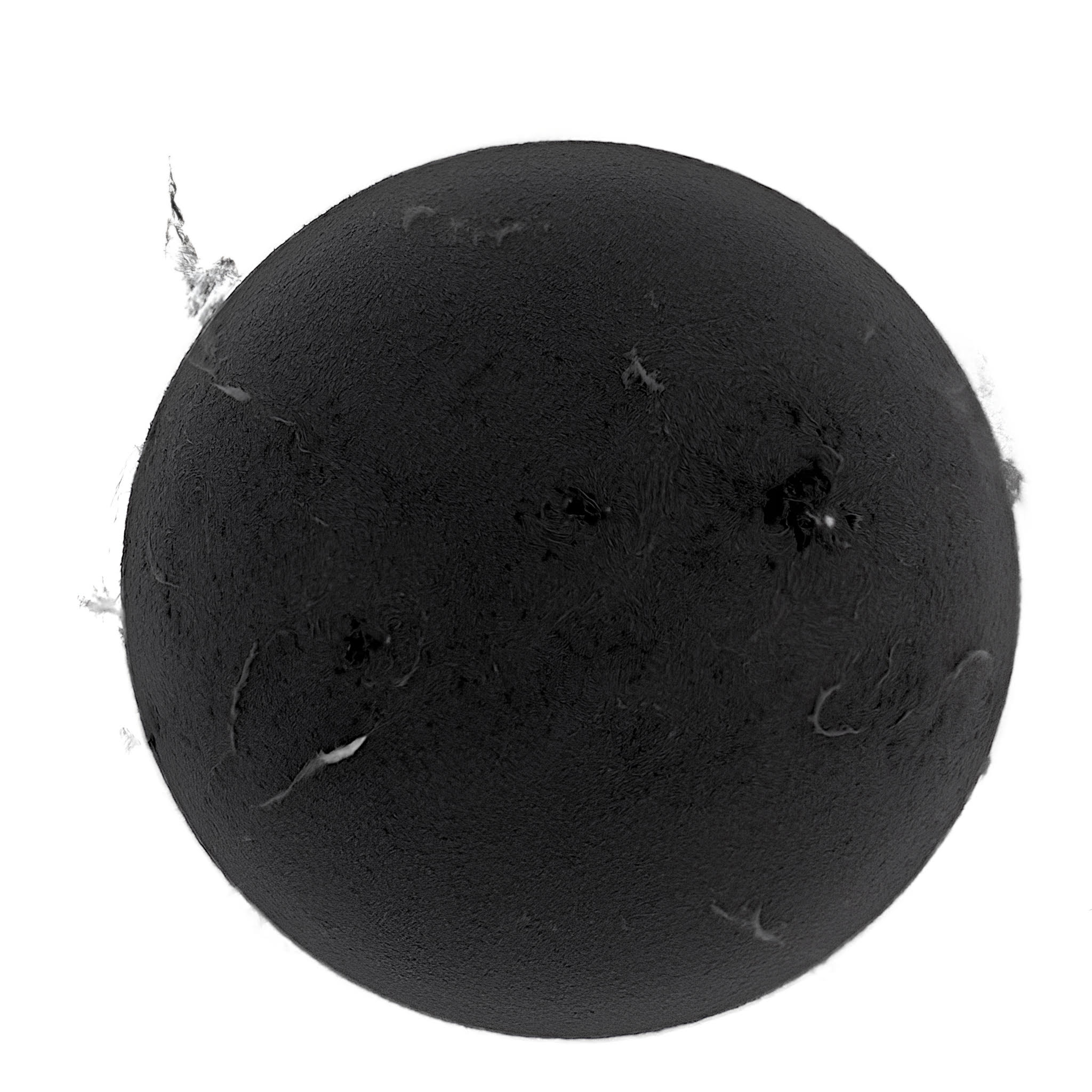Formation and evolution of a prominence on the south-east limb of the Sun |
H-alpha observations highlighting the formation and rapid evolution of an eruptive solar prominence at the south-eastern limb on December 29.
|
Eruprive prominence on the south-east limb of the Sun |
On November 28, 2025, the large sunspot appeared on the edge of the Sun. Just a few days earlier, it had been observed by the Perseverance rover directly from the surface of Mars, when it was located on the opposite side of our star with respect to Earth.
From its very first appearance, the region has shown extremely intense activity: a video created using chromospheric images acquired at the Catania Astrophysical Observatory clearly highlights the eruption of a spectacular prominence.
|
Quiescent prominence on the north-west limb of the Sun |
Image acquired on May 22 at 08:07 UT and processed to highlight a quiescent prominence on the northwestern limb of the Sun.
The prominence displays a typical arched shape and remains visible for several hours.
|
Spectacular prominence on the north-west limb of the Sun |
On May 7th, 2025, a huge prominence erupted from the Sun, stretching across hundreds of thousands of kilometers.
The processed image clearly highlights several filaments on the solar disk. They are structures composed of denser, cooler plasma confined along magnetic field lines.
|
A filament eruption on 09 April 2025 |
On April 9th, 2025, we observed the eruption of a filament located at the center of the solar disk, in the southern hemisphere. |
Cycle 25:
a record number of sunspots!
 |
As the solar maximum approaches, we are observing a significant increase in solar activity, with a record number of sunspots observed on the solar disk in the past July and August, the highest in 33 years!
On Friday, August 9th (the date of the disk you see), the sunspot count reached 380: to find a higher value, we have to go back to August 22, 1991, when it reached 401, during the peak of cycle 22.
The last time the Sun had this many sunspots, it was preparing to unleash the most powerful storms of the 21st century, those of November 2003.
Cycle 25 is therefore proving to be much more intense than expected.
|
A X3.9 Flare on 010 May 2024:
An aurora at low latitudes, an epochal event.
 |
On 10 May 2024
we observed a truly exceptional spectacle: an X3.98 class flare
occurred in the active region AR 13664 (start: 06:27,
peak:06:54). What really catches the attention is the
extraordinary size and complexity of active region 13664, which
has reached record dimensions of about 1200 millionths of the
solar hemisphere, corresponding to approximately 3600 million
square kilometers. A massive entity, roughly equivalent to 16
Earths, even larger than the planet Jupiter! All this reminds us
of the legendary Carrington Event of September 1st, 1859, when a
group of sunspots produced the most famous solar flare in
history. region.
This event
has caused a G4-class geomagnetic storm, the second-highest on
the scale. This has impacted satellite navigation systems such
as GPS and potential issues for satellites and spacecraft.
Additionally, it has generated auroras at very low latitudes.
Below we
present a movie of the aurora borealis seen at Serra la Nave
(Etna). The video is recorded between 20:41 local time on May
10th and 5:10 local time on May 11th whit an all-sky camera. It
shows also the apparent rotation of the stars. During moments
not covered by clouds, the constellation Ursa Major (or Big
Dipper) is clearly visible. The reddish coloration is due to the
excitation of oxygen atoms in the higher layers of the
atmosphere. The aurora takes on a red color only when the event
that gives rise to the phenomenon (the CME) is very energetic.
 |
A X4.5 Flare
on 06 May 2024
 |
On 06 May 2024
we observed a highly energetic flare occuring in Active Reagion
13663. It was a X4.5 GOES class flare (start: 05:38 UT, peak:
06:35 UT). This marks the third strongest solar flare of Solar
Cycle 25 and the most powerfull flare produced by this sunspot
region.
Below we
present a movie acquired at 131 Å by Solar Dynamic
Observatory (SDO). The movies are captured at uniform time
intervals.
 |
Picture of the day
28 March 2024 |
The spring is coming at the
Catania Astrophisical Observatory!
On March 22 2024, we observed
the flight of a swallow against the solar chromosphere, which
have many filament and Active Regions, at this time.
|
P-greek filament eruption
on 14 March 2024 |
On March 14 2024, we observed
the eruption of a filament in the the northern hemisphere of the
Sun, in a region without sunspots in the below photosphere. This
eruption gave rise to a CME and a G1-class geomagnetic storm in
the following days. The event occurred on Pi greek day, so we
called it Pi greek filament eruption.
|
A X1.7 Flare
on 22 February 2024
 |
On 22 February
2024 we observed a very energetic flare occurent in Active
Reagion 13590. It was a X1.7 GOES class flare (start: 05:50 UT,
peak: 06:30 UT). Below we show the light curve determined using
the full disk images in the center of the Hα line.
 |
A large filament eruption
on 12 February 2024 |
On February 12, 2024,we observed
the eruption of a large filament near the northeast limb of the
Sun, resulting in a CME and a G3-class geomagnetic storm in the
following days.Below we show the light curve determined using
the full disk images in the center of the Hαline.
 |
A Two Ribbons Flare on 16 February 2023
|
On 16 february 2023 we observed
a two ribbon flare near the west limb. It occurred in active
region NOAA 13216 and was C9.0 goes class (start: 10:16 ut,
peak: 10:59 ut).Below show light curve determined using full
disk images center of Hα line.
 |
A Solar Eclipse on 25 October 2022 |
On 25
October 2022 we were spectators of an unusual event: the
positions of the Sun and the Moon allowed us to observe a
partial eclipse of the Sun. The Sun and the Moon have almost
the same angular diameter when they are observed form the
Earth. A total solar eclipse occurs when the Moon is exactly
between the Earth and the Sun and projects its shadow on the
Earth. If an observer is placed on the path of such shadow the
Sun results totally obscured by the Moon. On October 25th we
observed a partial eclipse: the Moon and the Sun were not
exactly aligned and therefore only a part of the Sun was
obscured by the Moon. In Catania the eclipse began at 09:36
UT, the maximum, with a darkening of the solar disk of up to
about 13%, occurred around 10.31 UT. The event concluded at
11:27 UT. The next partial solar eclipse visible from some
cities of Italy is expected only in 2025. The movie on the
left represents the sequence of images of the solar disk
acquired by the solar telescope of INAF - Catania
Astrophysical Observatory. In the movie we show the solar
chromosphere at a wavelength corresponding to the center of
the Hα line (656.28 ± 0.25 nm). The raw images are recorded
with a size of 2048 x 2048 pixels and a dynamic range of 16
bit.
|